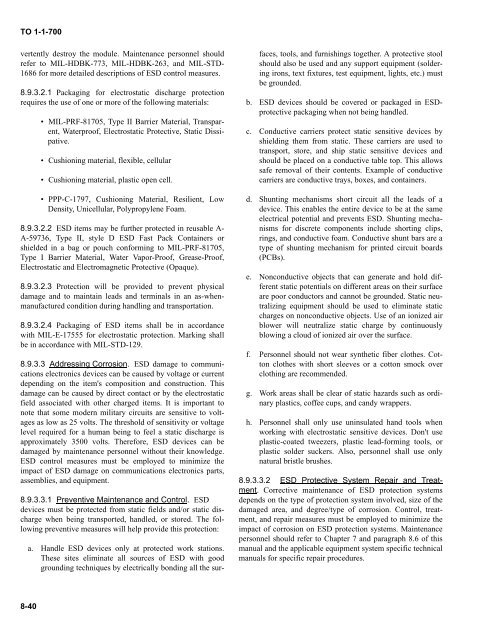TO 1-1-700 - Robins Air Force Base
TO 1-1-700 - Robins Air Force Base
TO 1-1-700 - Robins Air Force Base
Create successful ePaper yourself
Turn your PDF publications into a flip-book with our unique Google optimized e-Paper software.
<strong>TO</strong> 1-1-<strong>700</strong><br />
vertently destroy the module. Maintenance personnel should<br />
refer to MIL-HDBK-773, MIL-HDBK-263, and MIL-STD-<br />
1686 for more detailed descriptions of ESD control measures.<br />
8.9.3.2.1 Packaging for electrostatic discharge protection<br />
requires the use of one or more of the following materials:<br />
• MIL-PRF-81705, Type II Barrier Material, Transparent,<br />
Waterproof, Electrostatic Protective, Static Dissipative.<br />
• Cushioning material, flexible, cellular<br />
• Cushioning material, plastic open cell.<br />
• PPP-C-1797, Cushioning Material, Resilient, Low<br />
Density, Unicellular, Polypropylene Foam.<br />
8.9.3.2.2 ESD items may be further protected in reusable A-<br />
A-59736, Type II, style D ESD Fast Pack Containers or<br />
shielded in a bag or pouch conforming to MIL-PRF-81705,<br />
Type I Barrier Material, Water Vapor-Proof, Grease-Proof,<br />
Electrostatic and Electromagnetic Protective (Opaque).<br />
8.9.3.2.3 Protection will be provided to prevent physical<br />
damage and to maintain leads and terminals in an as-whenmanufactured<br />
condition during handling and transportation.<br />
8.9.3.2.4 Packaging of ESD items shall be in accordance<br />
with MIL-E-17555 for electrostatic protection. Marking shall<br />
be in accordance with MIL-STD-129.<br />
8.9.3.3 Addressing Corrosion. ESD damage to communications<br />
electronics devices can be caused by voltage or current<br />
depending on the item's composition and construction. This<br />
damage can be caused by direct contact or by the electrostatic<br />
field associated with other charged items. It is important to<br />
note that some modern military circuits are sensitive to voltages<br />
as low as 25 volts. The threshold of sensitivity or voltage<br />
level required for a human being to feel a static discharge is<br />
approximately 3500 volts. Therefore, ESD devices can be<br />
damaged by maintenance personnel without their knowledge.<br />
ESD control measures must be employed to minimize the<br />
impact of ESD damage on communications electronics parts,<br />
assemblies, and equipment.<br />
8.9.3.3.1 Preventive Maintenance and Control. ESD<br />
devices must be protected from static fields and/or static discharge<br />
when being transported, handled, or stored. The following<br />
preventive measures will help provide this protection:<br />
a. Handle ESD devices only at protected work stations.<br />
These sites eliminate all sources of ESD with good<br />
grounding techniques by electrically bonding all the surfaces,<br />
tools, and furnishings together. A protective stool<br />
should also be used and any support equipment (soldering<br />
irons, text fixtures, test equipment, lights, etc.) must<br />
be grounded.<br />
b. ESD devices should be covered or packaged in ESDprotective<br />
packaging when not being handled.<br />
c. Conductive carriers protect static sensitive devices by<br />
shielding them from static. These carriers are used to<br />
transport, store, and ship static sensitive devices and<br />
should be placed on a conductive table top. This allows<br />
safe removal of their contents. Example of conductive<br />
carriers are conductive trays, boxes, and containers.<br />
d. Shunting mechanisms short circuit all the leads of a<br />
device. This enables the entire device to be at the same<br />
electrical potential and prevents ESD. Shunting mechanisms<br />
for discrete components include shorting clips,<br />
rings, and conductive foam. Conductive shunt bars are a<br />
type of shunting mechanism for printed circuit boards<br />
(PCBs).<br />
e. Nonconductive objects that can generate and hold different<br />
static potentials on different areas on their surface<br />
are poor conductors and cannot be grounded. Static neutralizing<br />
equipment should be used to eliminate static<br />
charges on nonconductive objects. Use of an ionized air<br />
blower will neutralize static charge by continuously<br />
blowing a cloud of ionized air over the surface.<br />
f. Personnel should not wear synthetic fiber clothes. Cotton<br />
clothes with short sleeves or a cotton smock over<br />
clothing are recommended.<br />
g. Work areas shall be clear of static hazards such as ordinary<br />
plastics, coffee cups, and candy wrappers.<br />
h. Personnel shall only use uninsulated hand tools when<br />
working with electrostatic sensitive devices. Don't use<br />
plastic-coated tweezers, plastic lead-forming tools, or<br />
plastic solder suckers. Also, personnel shall use only<br />
natural bristle brushes.<br />
8.9.3.3.2 ESD Protective System Repair and Treatment.<br />
Corrective maintenance of ESD protection systems<br />
depends on the type of protection system involved, size of the<br />
damaged area, and degree/type of corrosion. Control, treatment,<br />
and repair measures must be employed to minimize the<br />
impact of corrosion on ESD protection systems. Maintenance<br />
personnel should refer to Chapter 7 and paragraph 8.6 of this<br />
manual and the applicable equipment system specific technical<br />
manuals for specific repair procedures.<br />
8-40
















